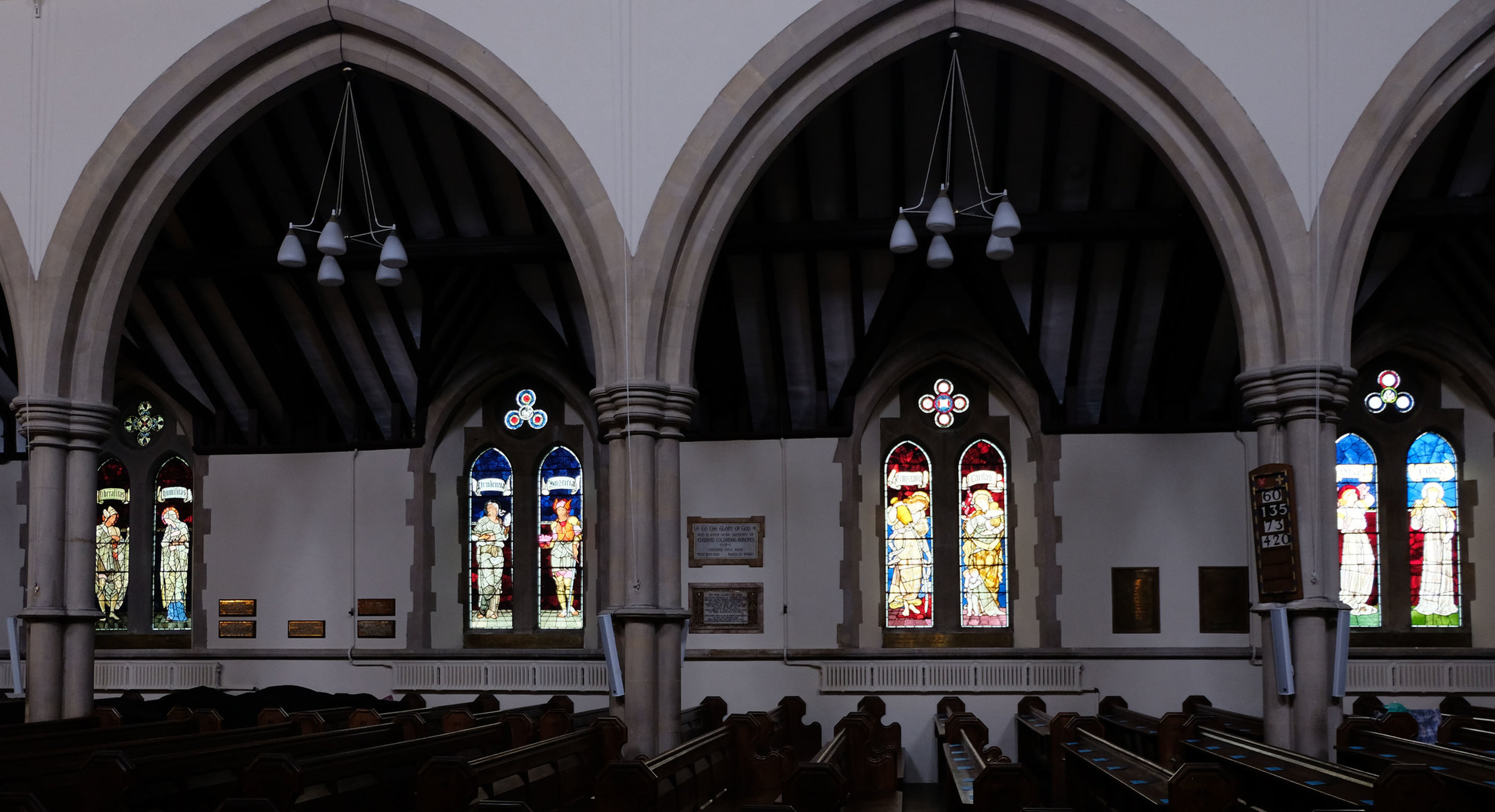Outer door, Inner door and inside the Church of St Alban, Westbury Park.
This is a church built beside an older one (still standing) that the congregation in the Bristol suburb of Westbury Park, had outgrown. The architect was CFW Denning, it was completed in 1915 with furnishings and stained glass in every window added over the following two decades. As a result the interior is cohesive and true to the arts and crafts ideals, with modest entrance doors, stone walls and wooden chairs amid the evidence of regular use by local groups. The designer of most of the wonderful stained glass in the church was Arnold Robinson, a pupil of Christopher Whall, who worked with and then bought the stained glass firm Joseph Bell & Son of Bristol. The east window (below and above right)) glitters with complementary purples, greens and browns and is crammed with detail - from rainbows and cherubs at the top to realistic figures of contemporary servicemen, with nurses, at the bottom.
The east window and detail , designed by Arnold Robinson, 1920.
Three windows in the north wall, two by Arnold Robinson, the third by Florence Camm.
Six of the nave windows are also by Robinson, on the north wall there is one by Florence Camm (1929) that fits in well with the general style although it’s very different in its decorative detailing. The details in Robinson’s windows show an interesting mix of pastel coloured streaky glass in chunky borders and characters in the nativity window that are taken from sources as diverse as Raphael’s Madonna della Seggiola (below left) and a toddler straight out of a 1920s popular illustration (below right).
Details from the nativity window (in the centre of the photo of the north wall).
South transept window by Margaret Chilton, 1915, and detail.
The window that is contemporary with the building of St Alban’s is a tall lofty one in the south transept by Margaret Chilton. It depicts classically dressed craftsmen working on the building, one holding up a model of it. The lower sections with eccentric leading, little squares of colour and finely drawn wild flowers has got a very Charles Rennie Mackintosh look about it, this window dates to three years before Chilton’s move to Glasgow.
Window 1 on the south wall and detail.
Continuing from that window along the south side of the nave are four more Robinson windows, all set in deep craggy recesses with sills covered in plastic sheets for groups of white candles. There are wonderful things to be found in all of these - in the first window there are little people processing towards the open door (above centre) and the handpainted note in memory of a local 2nd lieutenant (above right), a reminder of the boom in stained glass memorial windows caused by World War 1.
Window 2 on the south wall and detail.
The second window again has finely drawn flowers in the border, and clustered around the missionary Ruth Salisbury are a group of realistic, attentive children (above). The third window is in memory of a couple who were benefactors of St Alban’s, the details I picked out in this one are another group of little people including two sweet babies, and a walled town in the background (below).
Window 3 on the south wall and detail.
Window four (below) is a scene of the Revelation, with a wonderful sea shore, an angel with a visionary globe, a harp, a sword and a dedication to another young local 2nd lieutenant killed in the war.
Window 4 on the south wall and detail.
Looking west, windows by Arnold Robinson.
Coming to the west end of the church (above) are a pair of windows by Robinson from 1925, where pastel coloured angels soar above a nativity scene and an ascending figure of Christ. The ordered composition, pale backgrounds and geometric rays of light are in great contrast to the colourful riot of the Te Deum east window. Finally, in the baptistry and now cut off by a glass partition, are two smaller pairs of windows of small people, or cherub children with realistic heads (below). They are the work of Margaret Chilton, given by members of the Mothers’ Union in 1915. The font has been moved out of this space which is now a play area. I wonder if this was because the images of the cherub children were considered disturbing, or even confusing because of the popular belief that the dead turn into angels, whereas in Christian doctrine they are two different things. It’s hard to imagine this sort of imagery, thought provoking and poignant in a time of war, being allowed anywhere near a baptistry these days.
Two pairs of windows inside the baptistry by Margaret Chilton 1915.















